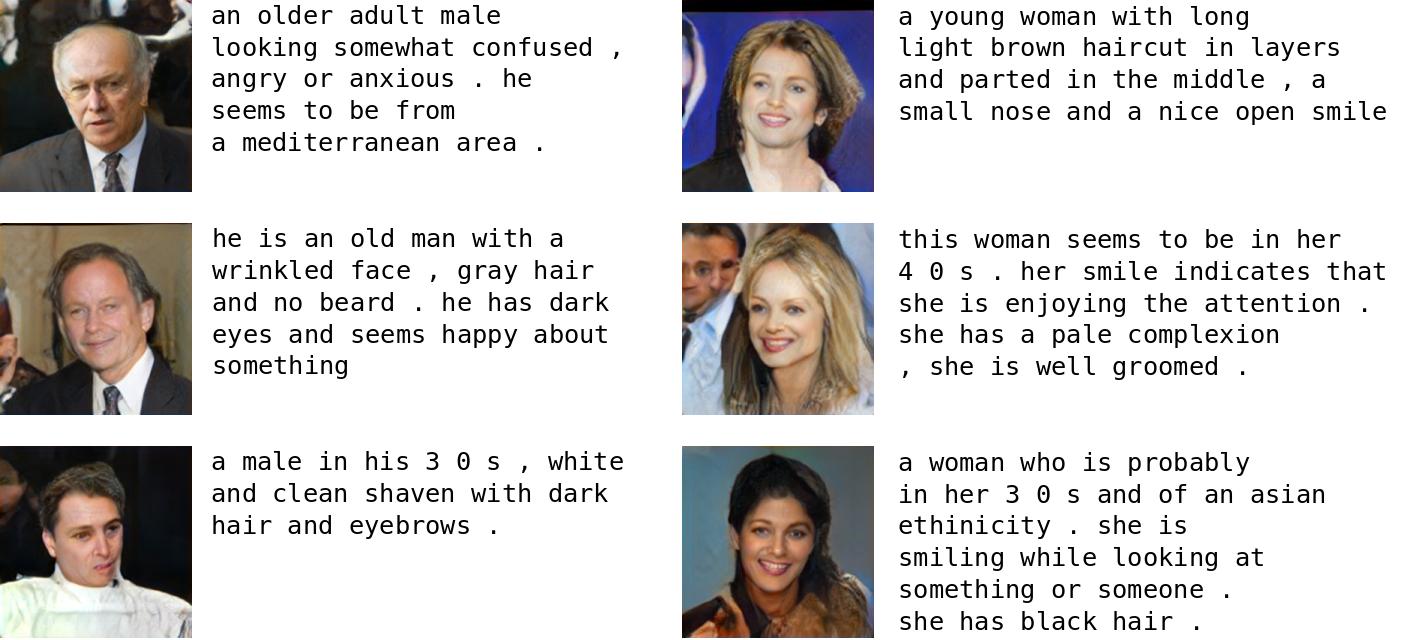Ecosyste.ms: Awesome
An open API service indexing awesome lists of open source software.
https://github.com/akanimax/T2F
T2F: text to face generation using Deep Learning
https://github.com/akanimax/T2F
adversarial-machine-learning gan generative-adversarial-network progressively-growing-gan text-to-image
Last synced: about 2 months ago
JSON representation
T2F: text to face generation using Deep Learning
- Host: GitHub
- URL: https://github.com/akanimax/T2F
- Owner: akanimax
- License: mit
- Created: 2018-06-22T05:19:07.000Z (almost 6 years ago)
- Default Branch: master
- Last Pushed: 2022-05-14T20:34:32.000Z (about 2 years ago)
- Last Synced: 2024-01-26T20:34:37.114Z (4 months ago)
- Topics: adversarial-machine-learning, gan, generative-adversarial-network, progressively-growing-gan, text-to-image
- Language: Python
- Homepage:
- Size: 498 MB
- Stars: 543
- Watchers: 35
- Forks: 104
- Open Issues: 18
-
Metadata Files:
- Readme: README.md
- License: LICENSE
Lists
- Awesome-pytorch-list - T2F - to-Face generation using Deep Learning. This project combines two of the recent architectures StackGAN and ProGAN for synthesizing faces from textual descriptions. (Paper implementations / Other libraries:)
- my-awesome-stars - akanimax/T2F - T2F: text to face generation using Deep Learning (Python)
- awesome-stars - T2F
- Awesome-pytorch-list-CNVersion - T2F - to-Face生成。该项目结合了[StackGAN](https://arxiv.org/abs/1710.10916)和[ProGAN](https://arxiv.org/abs/1710.10196),这两个模型可以基于文字描述合成人脸。 (Paper implementations|论文实现 / Other libraries|其他库:)
README
# ! Attention !
# This project is unfortunately not being worked upon
### Please head over to the following much cooler project that takes the idea of Text-2-Image generation to the next level:
DallE: [Original](https://github.com/openai/DALL-E) [PyTorch](https://github.com/lucidrains/DALLE-pytorch)
#
#
#
#
#
# :star: [NEW] :star:
# T2F - 2.0 Teaser (coming soon ...)

## Please note that all the faces in the above samples are generated ones. The T2F 2.0 will be using MSG-GAN for the image generation module instead of ProGAN. Please refer [link](https://github.com/akanimax/BMSG-GAN) for more info about MSG-GAN. This update to the repository will be comeing soon :+1:.
# T2F
Text-to-Face generation using Deep Learning. This project combines two of the recent architectures StackGAN and ProGAN for synthesizing faces from textual descriptions.
The project uses Face2Text dataset which contains 400 facial images and textual captions for each of them. The data can be obtained by contacting either the **RIVAL** group or the authors of the aforementioned paper.
Some Examples:

Architecture:

The textual description is encoded into a summary vector using an LSTM network. The summary vector, i.e. Embedding (psy_t) as shown in the diagram is passed through the Conditioning Augmentation block (a single linear layer) to obtain the textual part of the latent vector (uses VAE like reparameterization technique) for the GAN as input. The second part of the latent vector is random gaussian noise. The latent vector so produced is fed to the generator part of the GAN, while the embedding is fed to the final layer of the discriminator for conditional distribution matching. The training of the GAN progresses exactly as mentioned in the ProGAN paper; i.e. layer by layer at increasing spatial resolutions. The new layer is introduced using the fade-in technique to avoid destroying previous learning.
## Running the code:
The code is present in the `implementation/` subdirectory. The implementation is done using the PyTorch framework. So, for running this code, please install `PyTorch version 0.4.0` before continuing.
__Code organization:__
`configs`: contains the configuration files for training the network. (You can use any one, or create your own)
`data_processing`: package containing data processing and loading modules
`networks`: package contains network implementation
`processed_annotations`: directory stores output of running `process_text_annotations.py` script
`process_text_annotations.py`: processes the captions and stores output in `processed_annotations/` directory. (no need to run this script; the pickle file is included in the repo.)
`train_network.py`: script for running the training the network
__Sample configuration:__
# All paths to different required data objects
images_dir: "../data/LFW/lfw"
processed_text_file: "processed_annotations/processed_text.pkl"
log_dir: "training_runs/11/losses/"
sample_dir: "training_runs/11/generated_samples/"
save_dir: "training_runs/11/saved_models/"
# Hyperparameters for the Model
captions_length: 100
img_dims:
- 64
- 64
# LSTM hyperparameters
embedding_size: 128
hidden_size: 256
num_layers: 3 # number of LSTM cells in the encoder network
# Conditioning Augmentation hyperparameters
ca_out_size: 178
# Pro GAN hyperparameters
depth: 5
latent_size: 256
learning_rate: 0.001
beta_1: 0
beta_2: 0
eps: 0.00000001
drift: 0.001
n_critic: 1
# Training hyperparameters:
epochs:
- 160
- 80
- 40
- 20
- 10
# % of epochs for fading in the new layer
fade_in_percentage:
- 85
- 85
- 85
- 85
- 85
batch_sizes:
- 16
- 16
- 16
- 16
- 16
num_workers: 3
feedback_factor: 7 # number of logs generated per epoch
checkpoint_factor: 2 # save the models after these many epochs
use_matching_aware_discriminator: True # use the matching aware discriminator
Use the `requirements.txt` to install all the dependencies for the project.
$ workon [your virtual environment]
$ pip install -r requirements.txt
__Sample run:__
$ mkdir training_runs
$ mkdir training_runs/generated_samples training_runs/losses training_runs/saved_models
$ train_network.py --config=configs/11.comf
## Other links:
blog: https://medium.com/@animeshsk3/t2f-text-to-face-generation-using-deep-learning-b3b6ba5a5a93
training_time_lapse video: https://www.youtube.com/watch?v=NO_l87rPDb8
ProGAN package (Seperate library): https://github.com/akanimax/pro_gan_pytorch
## #TODO:
1.) Create a simple `demo.py` for running inference on the trained models